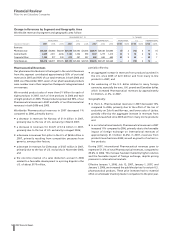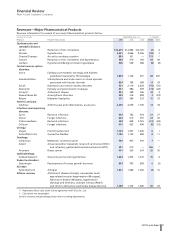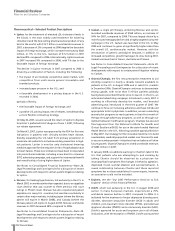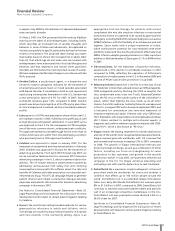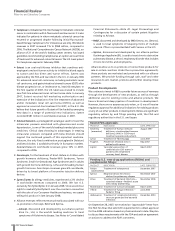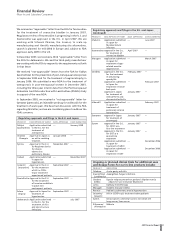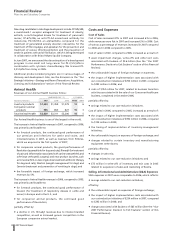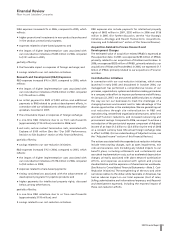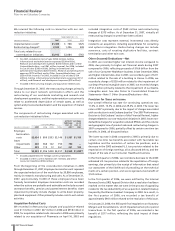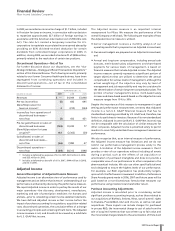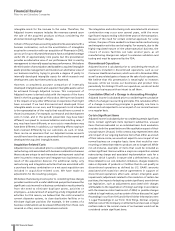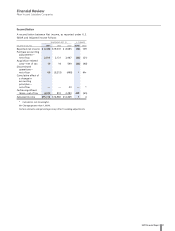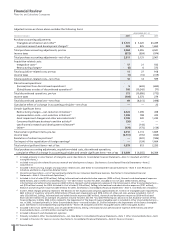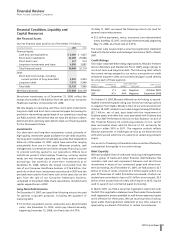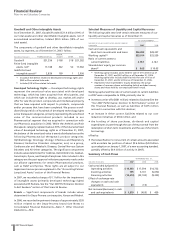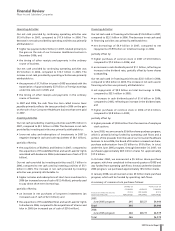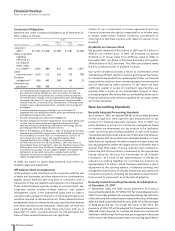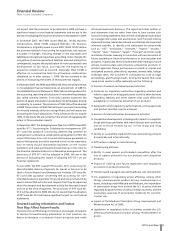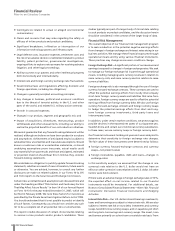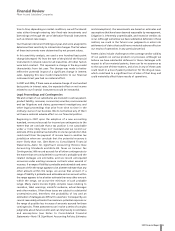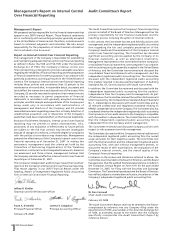Pfizer 2007 Annual Report Download - page 28
Download and view the complete annual report
Please find page 28 of the 2007 Pfizer annual report below. You can navigate through the pages in the report by either clicking on the pages listed below, or by using the keyword search tool below to find specific information within the annual report.
26 2007 Financial Report
Financial Review
Pfizer Inc and Subsidiary Companies
intangible assets for the increase to fair value. Therefore, the
Adjusted income measure includes the revenues earned upon
the sale of the acquired products without considering the
aforementioned significant charges.
Certain of the purchase-accounting adjustments associated with a
business combination, such as the amortization of intangibles
acquired in connection with our acquisition of Pharmacia in 2003,
can occur for up to 40 years (these assets have a weighted-average
useful life of approximately nine years), but this presentation
provides an alternative view of our performance that is used by
management to internally assess business performance. We believe
the elimination of amortization attributable to acquired intangible
assets provides management and investors an alternative view of
our business results by trying to provide a degree of parity to
internally developed intangible assets for which research and
development costs have been previously expensed.
However, a completely accurate comparison of internally
developed intangible assets and acquired intangible assets cannot
be achieved through Adjusted income. This component of
Adjusted income is derived solely with the impacts of the items
listed in the first paragraph of this section. We have not factored
in the impacts of any other differences in experience that might
have occurred if we had discovered and developed those
intangible assets on our own, and this approach is not intended
to be representative of the results that would have occurred in
those circumstances. For example, our research and development
costs in total, and in the periods presented, may have been
different; our speed to commercialization and resulting sales, if
any, may have been different; or our costs to manufacture may
have been different. In addition, our marketing efforts may have
been received differently by our customers. As such, in total,
there can be no assurance that our Adjusted income amounts
would have been the same as presented had we discovered and
developed the acquired intangible assets.
Acquisition-Related Costs
Adjusted income is calculated prior to considering integration and
restructuring costs associated with business combinations because
these costs are unique to each transaction and represent costs that
were incurred to restructure and integrate two businesses as a
result of the acquisition decision. For additional clarity, only
restructuring and integration activities that are associated with
a purchase business combination or a net-asset acquisition are
included in acquisition-related costs. We have made no
adjustments for the resulting synergies.
We believe that viewing income prior to considering these charges
provides investors with a useful additional perspective because the
significant costs incurred in a business combination result primarily
from the need to eliminate duplicate assets, activities or
employees—a natural result of acquiring a fully integrated set of
activities. For this reason, we believe that the costs incurred to
convert disparate systems, to close duplicative facilities or to
eliminate duplicate positions (for example, in the context of a
business combination) can be viewed differently from those costs
incurred in other, more normal business contexts.
The integration and restructuring costs associated with a business
combination may occur over several years, with the more
significant impacts ending within three years of the transaction.
Because of the need for certain external approvals for some
actions, the span of time needed to achieve certain restructuring
and integration activities can be lengthy. For example, due to the
highly regulated nature of the pharmaceutical business, the
closure of excess facilities can take several years, as all
manufacturing changes are subject to extensive validation and
testing and must be approved by the FDA.
Discontinued Operations
Adjusted income is calculated prior to considering the results of
operations included in discontinued operations, such as our
Consumer Healthcare business, which we sold in December 2006,
as well as any related gains or losses on the sale of such operations.
We believe that this presentation is meaningful to investors
because, while we review our businesses and product lines
periodically for strategic fit with our operations, we do not build
or run our businesses with an intent to sell them.
Cumulative Effect of a Change in Accounting Principles
Adjusted income is calculated prior to considering the cumulative
effect of a change in accounting principles. The cumulative effect
of a change in accounting principles is generally one time in
nature and not expected to occur as part of our normal business
on a regular basis.
Certain Significant Items
Adjusted income is calculated prior to considering certain significant
items. Certain significant items represent substantive, unusual
items that are evaluated on an individual basis. Such evaluation
considers both the quantitative and the qualitative aspect of their
unusual nature. Unusual, in this context, may represent items that
are not part of our ongoing business; items that, either as a result
of their nature or size, we would not expect to occur as part of our
normal business on a regular basis; items that would be non-
recurring; or items that relate to products we no longer sell. While
not all-inclusive, examples of items that could be included as
certain significant items would be a major non-acquisition-related
restructuring charge and associated implementation costs for a
program which is specific in nature with a defined term, such as
those related to our cost-reduction initiatives; charges related to
sales or disposals of products or facilities that do not qualify as
discontinued operations as defined by U.S. GAAP; amounts
associated with transition service agreements in support of
discontinued operations after sale; certain intangible asset
impairments; adjustments related to the resolution of certain tax
positions; the impact of adopting certain significant, event-driven
tax legislation, such as adjustments associated with charges
attributable to the repatriation of foreign earnings in accordance
with the American Jobs Creation Act of 2004; or possible charges
related to legal matters, such as certain of those discussed in Legal
Proceedings in our Form 10-K and in Part II: Other Information; Item
1, Legal Proceedings in our Form 10-Q filings. Normal, ongoing
defense costs of the Company or settlements and accruals on legal
matters made in the normal course of our business would not be
considered certain significant items.


